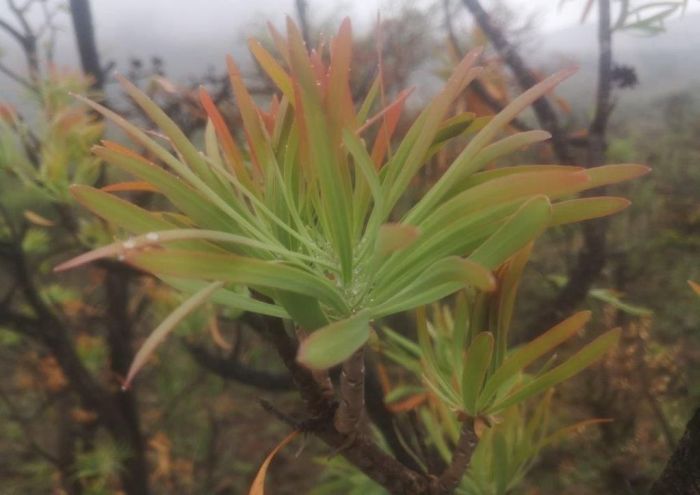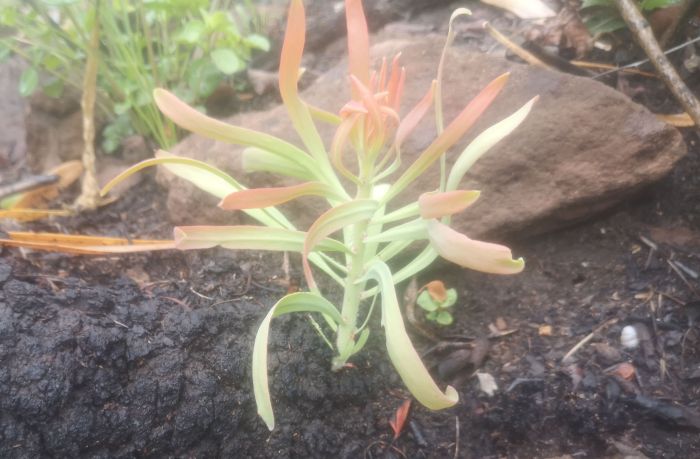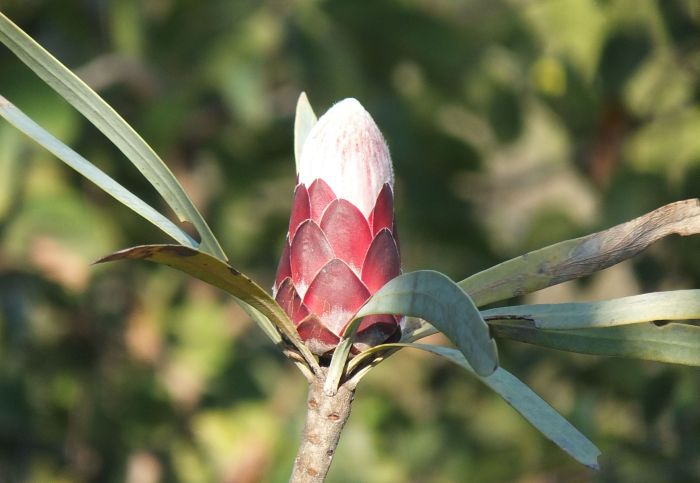Protea curvata
Protea curvata N.E.Br.
Family: Proteaceae
Common names: Barberton sugarbush, Barberton lowveld sugarbush, serpentine sugarbush (Eng.); barbertonlaeveldsuikerbos, serpentynsuikerbos (Afr.)
SA Tree No: 88.1
Introduction
A rare tree with spectacular, deep pink bracts and pale pink flowers in winter, that has potential as a garden ornamental for summer rainfall gardens.

Description
Description
Protea curvata is a slender, evergreen tree that can reach up to 8 m high, and produces a trunk of 100–300 mm in diameter. Bark is brown when young and black when mature. The leaves of the current year are clustered, leathery, hairless, glaucous and narrowly oblong-lanceolate, sickle shaped, 110–200 mm long and 8–16 mm wide.

Protea curvata produces globose flower heads that are 50–70 mm in diameter. The involucral bracts are deep pink, with silky to velvety hairs on the margins and hairless below; the outer series of bracts are ovate, 7–30 mm long and 10–15 mm wide, the inner series are ovate to oblong, 20–30 mm long and 8–16 mm wide. The perianth is 50–60 mm long, pink, with short, pale hairs. Male and female parts are carried in the same flower. The female consists of a stigma, style and ovary, and the style has a modified tip that carries the pollen when the flower is open, called the pollen presenter. The style is pink, straight, about 60–65 mm long and the pollen presenter is 15 mm long. The male consists of anthers that are attached to the perianth. Before the flower opens, the anthers press their load of pollen onto the pollen presenter, and when the flower opens, the perianth falls away.
The plant begins flowering in autumn (May) and continues until late spring (October) and flowers with abundance in midwinter (June and July). The heads will remain open and shed the seeds 4 months after flowering, in early summer (October to December).
Protea curvata is similar to a form of P. caffra, previously known as P. rhodantha var. falcata, that occurs in the east of Claremont Vale. They both have sickle-shaped leaves and a similar growth habit, but the latter has typical P. caffra flower heads.
Conservation Status
Status
Protea curvata is assessed as Vulnerable (VU) in the Red List of South African plants. It is a rare species with a very restricted natural range. It is potentially threatened by loss of habitat because of mining activities, and should mining resume, it is likely to become Critically Endangered or even Extinct in the Wild.

Distribution and habitat
Distribution description
Protea curvata is endemic to the mountains around Barberton, Mpumalanga, on the Drakensberg Escarpment. The plants are found growing on the summit ridge and southern lip of a low koppie on the farm, Claremont Vale, near Caledonian siding, by Suidkaap River. This species grows in Barberton Serpentine Sourveld, in bushveld, in subtropical, summer rainfall, varying from 600–750 mm, in hot and steamy conditions, on talcose serpentine soil of the Jamestown Schist Belt, derived from ultra-basic rocks, at 850 m altitude above sea level.

Derivation of name and historical aspects
History
Ernest Edward Galpin was the first botanist to discover Protea curvata on the 13 July 1895. He was a banker from Barbeton who had an interest in plants and gained fame as an amateur botanist. Galpin received recognition as a plant collector by ardent naturalist and botanist, Field-Marshal J. C. Smuts, who dubbed him ‘the prince of collectors’.
It then took years before Protea curvata was seen again, even though it had locality data pinpointing the original collection. In 1956, Dr J.S. Beard began to revise the proteas of the summer rainfall area of South Africa, with assistance of Dr P.D. Hamilton, a medical practitioner of Barberton. They both managed to trace the original locality, about 8 kilometers north of Barberton. However, Steve Fourie of the Mpumalanga Department of Nature Conservation in Claremont Vale discovered another stand.
Protea curvata was introduced to commercial horticulture by Mr E.R. Middelmann in 1960 through Honingklip Nurseries, and 15 years later, the species was cultivated at the Kirstenbosch National Botanical Garden.
The genus Protea was named by the father of taxonomy, Carl Linnaeus, after Proteus, the mythological Greek god, who could change his form at will. This name suitably recognizes the wide variety of forms that the protea family exhibits. The species name curvata means ‘curved’. This refers to the slightly curved leaves of the species.

Ecology
Ecology
Protea curvata is a long-lived species, and a resprouter, which means that it can survive fires and regenerates by resprouting after the fire. It can also regenerate by seed. The plant survives the grassland fires because of its thick, heavy bark that gives the cambium enough protection and new shoots sprout from the subcortical layers after the fire. The resprouting takes place on the aerial stems. The seedlings are protected from the fire by an underground bulbous lignotuber.

The seeds are small and covered with fine hairs (pappus), which aid wind distribution. An abscission layer develops under the base of the inflorescence when the fruit reaches maturity. Interestingly, when you touch the abscission layer, it detaches and falls to the ground, spilling its fruits.
Birds are the pollinators of the flowers.
Uses
Use
This tree is best suited for summer rainfall gardens. However, there is no record of one growing in the garden to reach maturity. The tree in its natural habitat grows together with Themeda grass, Gnidia sp., Combretum spp., Bolusanthus speciosus, Senegalia caffra and Pavetta edentula.

Growing Protea curvata
Grow
Protea curvata is propagated by seed collected in early summer (October to December) and sown in the following spring (August to September). It is important to select fertile seeds, which are fat, whereas infertile seeds show no substance. Treat the seeds by dusting them with a systemic fungicide, to prevent rotting of the seeds. Sow the seeds in well-drained soil. After sowing, sprinkle a light layer of sand to cover any exposed seed.
Keep the soil moist, but do not overwater. Allow the soil to dry out a little between watering. The seed begins to germinate 40 days after sowing. The seedlings produce fleshy cotyledons, followed by true leaves and develop a lignotuber for the first few years, until the shoot growth begins to speed up. Pot out the seedlings at the cotyledon stage, or when the first true leaves appear; this reduces the plant stress and advances the survival rate.
The seedlings have a medium growth rate and can reach up to 30 cm in 3 years. Plant the plants in the garden during the spring season and water them until the tree roots are established.
Propagation from cuttings has been unsuccessful because the leaves develop a fungal infection, turn black and drop.
References
- Protea Atlas Project, Protea Gallery, Mountain Surgarbushes – Proteas. https://www.proteaatlas.org.za/sugar16.htm.
- Rebelo, A.G. 2001. Proteas. A field guide to the proteas of southern Africa. Fernwood Press, Vlaeberg, Cape Town.
- Rebelo, A.G., Mtshali, H. & Von Staden, L. 2019. Protea curvata N.E.Br. National Assessment: Red List of South African plants version 2020.1. Accessed on 2020/09/02.
- Rourke, J.P. 1980. Proteas of South Africa. Tafelberg, Cape Town, Johannesburg.
- Vogts, M. 1982. South Africa's Proteaceae: know them and grow them. Struik, Cape Town.
Credits
Mashudu Nndanduleni
Kirstenbosch National Botanical Garden
October 2020
Acknowledgements: the author thanks Prof. Kevin Balkwill for images of Protea curvata in flower.
Plant Attributes:
Plant Type: Tree
SA Distribution: Mpumalanga
Soil type: Sandy
Flowering season: Spring, Autumn, Winter
PH:
Flower colour: Red, White, Pink
Aspect: Full Sun
Gardening skill: Challenging
Special Features:
Horticultural zones








Rate this article
Article well written and informative
Rate this plant
Is this an interesting plant?
Login to add your Comment
Back to topNot registered yet? Click here to register.